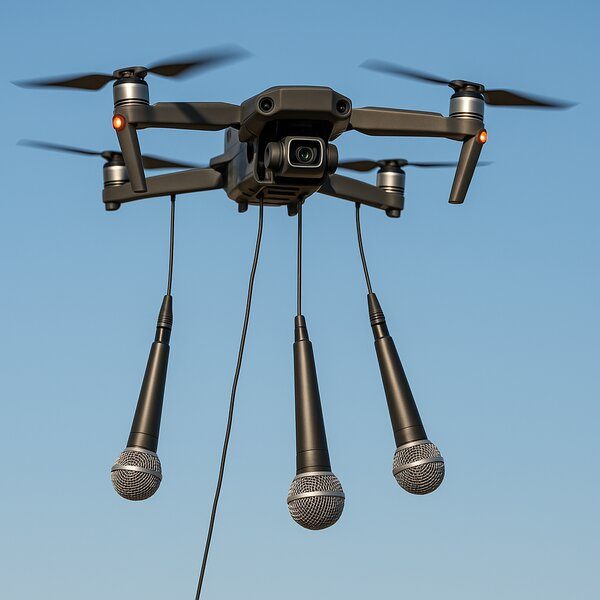Do Drones Have Microphones? Everything You Need to Know
As drone usage continues to rise across Australia — from aerial cinematography to inspections and recreational flying — a common question keeps surfacing: do drones have microphones? Whether you’re concerned about privacy or interested in capturing rich sound to match your visuals, this article dives into everything you need to know about drones and audio recording.
Can Drones Listen to Conversations?
This is one of the most frequently asked questions from both drone enthusiasts and those concerned about surveillance. The short answer is: no, drones generally cannot listen to conversations.
Most consumer and professional drones on the market today do not come equipped with audio recording capabilities that could pick up human conversations from the air. The main reason is environmental: drones are inherently noisy. The propellers and motors generate constant sound interference, which would drown out any useful audio, especially speech from ground level.

Can Drones Have Microphones?
Technically, yes — it is possible to attach a microphone to a drone. However, this is rarely done in practice. Here’s why:
- Noise interference: The drone’s own operational noise makes capturing clear audio extremely difficult.
- Legal limitations: Recording private conversations without consent may breach Australian privacy laws.
- Weight and power: Adding external audio equipment increases the drone’s payload, reducing flight time and performance.
- Signal transmission: Real-time audio transmission from a flying drone introduces latency and reliability issues.
So while the answer to can drones have microphones is yes in theory, it’s highly impractical and rarely used in professional workflows.
Can You Record with a Drone?
Yes — you can absolutely record video footage with a drone. In fact, this is what drones are best known for. Drones like the DJI Inspire 3 and Mavic 4 Pro are equipped with advanced imaging sensors capable of capturing stunning 4K to 8K video content. However, this footage does not include audio.
Why Does Drone Footage Not Have Audio In It?
The lack of onboard microphones in drones is not a flaw — it’s intentional. Due to the high decibel levels produced by rotors and motors, any built-in microphone would primarily capture this mechanical noise. The result would be unusable for most professional or consumer needs.
Instead, drone operators who want sound to accompany aerial footage typically use one of these methods:
- External audio recorders on the ground to capture ambient sound separately
- ADR (automated dialogue replacement) or foley during post-production
- Music or licensed audio overlays to enhance the video
So if you’ve ever wondered why does drone footage not have audio in it, it’s by design — to prioritise clean visuals without distorted or irrelevant noise.
What Drone Can Record Sound?
While most mainstream drones, including professional models used in Australia, do not record audio, there are a few exceptions:
- Toy-grade drones: Some low-cost models aimed at children include rudimentary microphones. However, the audio quality is extremely poor and mostly a novelty.
- Action camera drones: Drones fitted with cameras like GoPro (if unmodified) may record ambient sound, but only in very controlled conditions and without useful range.
If your goal is to capture synchronised sound and video from the air, your best bet is to record the audio separately and sync it in post-production.
Can a Drone Record Audio?
To clarify: standard drones cannot record audio because they lack onboard microphones. However, if you are technically inclined, it is possible to modify a drone or attach a small recorder. This is not common practice and introduces several challenges:
- Increased weight and reduced flight time
- Battery draw from the additional device
- Substantial post-processing needed to clean up noise
As drone cinematographers, we at Flying Glass have tested various methods to capture aerial sound. The best result still comes from ground-level recordings or from cameras mounted on gimbals in stable environments, away from rotor noise.
Can Drones Transmit Sound or Recordings?
This is a popular question in both hobbyist and security circles. Some military-grade drones and surveillance RPAs (Remotely Piloted Aircraft) may have specialised audio gear, but consumer and prosumer drones available in Australia do not transmit or record sound in real-time.
Even if you were to record audio onboard, transmitting it in real time would require additional bandwidth and signal reliability that most standard drone systems aren’t equipped for. The focus for manufacturers is on video quality, range, and control — not live audio streaming.
Why Are Microphones Rare in Drones?
The reasons are both technical and legal:
- Audio distortion from drone motors makes recordings unusable.
- Privacy laws in Australia restrict audio surveillance without consent.
- Regulatory compliance under CASA (Civil Aviation Safety Authority) does not require or favour sound-capturing drones.
- Professional workflows separate audio and video to ensure higher quality output.
Best Practices for Capturing Sound with Drone Footage
If you want sound to accompany your drone visuals, here are the best industry practices:
- Record sound on the ground using high-quality microphones or lavaliers.
- Use directional mics to focus on specific sound sources away from background noise.
- Add licensed music tracks during editing to elevate the viewer experience.
- Sync environmental sound effects like wind, waves, or crowds in post-production for realism.
At Flying Glass, we often film sweeping shots over coastlines, forests, or cityscapes. We add rich ambient sound or music during post to complement the vision, creating an immersive experience without relying on unusable drone audio.
Training and Rules for Flying Drones with Recording Equipment
Whether or not your drone is equipped with sound gear, it’s important to understand your obligations under Australian law. If you’re flying drones for commercial purposes, including film, TV or marketing content, you must operate under an Operator’s Certificate (OC) and hold a valid Remote Pilot Licence (RePL).
We offer drone training courses that cover all the technical and legal aspects of safe, compliant flying. This includes best practices for equipment mounting, sensor payloads, and respecting privacy when flying over people or properties.
Need Audio for Your Aerial Project?
If you’re working on a film, TVC or branded content piece and need aerial footage with audio, we can help. At Flying Glass, we offer:
- Stunning 5K to 8K aerial footage using industry-leading drones
- Ground-level audio capture with professional-grade microphones
- Audio and video synchronisation for polished final delivery
If you don’t have the right permissions, gear, or knowledge to capture what you need, contact us and we’ll take care of the shoot for you.
Conclusion
To summarise:
- Do drones have microphones? Most do not.
- Can drones record audio? Not in any meaningful way due to interference.
- Can you record with a drone? Yes — stunning video, not audio.
- Why does drone footage not have audio in it? Rotor noise makes it unusable.
- Can drones transmit or listen in? Consumer drones cannot. Military drones are a different category altogether.
So, while drones are extraordinary tools for capturing visual content, their role in audio capture is extremely limited. Whether you’re a content creator, a business or a production company — knowing the limitations helps you plan better. If you need professional help, our experienced team at Flying Glass is just a call away.

